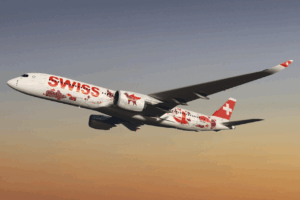
Southwest Airlines (NYSE: LUV) posted a third-quarter surprise profit that was accompanied by record revenues earlier today. However, shares are trading down around 7% given management’s more cautious fourth-quarter revenue outlook, demonstrating a classic example of rhetoric guiding the tape. The airline guided unit revenue growth of around 1-3%, while the company is also increasing capacity by around 6%. This serves as a clear warning that the recent government shutdown and other operational complications are eroding Southwest’s pricing power.
The company reaffirmed its full-year earnings before interest and taxes (EBIT) outlook at $600-$800 million. The airline is also looking to add assigned and extra-legroom seating for travel starting in January 2026, which is in line with the earlier plans. This print shows operational progress, but also highlights a relatively cautious tone. The addition of near-term capacity with weaker demand was quick to temper enthusiasm over an earnings beat, driving a selloff despite a good third quarter. Elliott Management, the silent force behind all of Southwest’s latest changes, is certainly seeing its operational vision for the airline come to life, but without the financial outperformance it is hoping for (at least for now).
Earnings Performance & Core Drivers
Third-quarter operating revenue was printed at a record $6.9 billion, with net income rising to $54 million. Adjusted earnings per share for the quarter were reported at $0.11, significantly ahead of the Street’s consensus. Unit revenues rose around 0.4% on capacity growing throughout the quarter by 0.8%. Costs per available seat mile (excluding fuel) rose just 2.5%, despite major industry headwinds, which had analysts penciling this figure in higher. Overall demand inflected in July and held throughout the quarter, with Southwest’s limited share of the corporate and premium market also continuing to grow.
Loyalty revenues jumped by 7%, with co-branded signups rising by double-digit figures. Southwest Airlines took delivery of eight Boeing 737 MAX 8 jets and subsequently retired 16 models, allowing it to end the third quarter with 802 jets in its fleet. For the fourth quarter, guidance calls for record operating revenue, strong RASM and CASM performance, reasonable fuel prices (despite the airline’s lack of hedging efforts), despite some challenges related to overall holiday demand, according to the airline’s earnings release.
What Does All Of This Mean For Southwest Airlines?
From a strategic perspective, this quarter confirms Southwest’s overall transformation and the traction the airline is gaining when it comes to cost control, better products, and overall loyalty monetization. All of these are core factors driving Elliott Management’s activist investment thesis. The near-term revenue bar for the airline is lower than what bullish analysts had penciled in, with revenues only guided up by around 1-3% while capacity is growing significantly faster than that.
This highlights modest pricing power going into the holidays, especially with the government shutdown being cited as a principal drag. The airline’s retrofit shift will help it boost available seats, but it is deferring its premium product mix until 2026, shifting to a constructive “prove-it” story when it comes to overall premium demand growth.
The airline’s focus, however, remains on execution. Keeping costs near guidance and showing an ability to target peak holiday demand will be critical for the airline as it looks to upsell new kinds of seating products, especially if Elliott Management is looking to hit its price targets in the future.
What Do We Make Of All Of This?
Southwest Airlines, a budget airline, has continued to struggle over the past six quarters, even with the activist intervention from Elliott Management that sought to change pretty much everything about how the airline interacted with customers and the market. The new structure, which Elliott has pushed forward, is beginning to take form.
Cost discipline has been Southwest’s strength, and anyone familiar with Elliott’s work would not be surprised by the steps that they have taken. Cost simplification strategies and attempts to generate more revenue (specifically through add-on services and the elimination of many premium benefits) have both had a positive impact on the airline.
The challenge, however, is that Southwest is now exposed to more macroeconomic risk than it was before. Its customer base is now primarily motivated by price and schedule convenience. This requires the airline to cut fares and increase frequencies (as we can see in the airline’s capacity jump), although macroeconomic uncertainty in the economy is making it harder for them to fill some of these seats. Fuel price hikes could also hurt the airline, which dissolved its fuel hedging division earlier in the year.






